Skin Disorders in Older Adults: Vascular, Lymphatic, and Purpuric Dermatitides, Part 1
All elements of the skin are affected by age. In this 2-part article, I will discuss how the blood vessels, the lymphatics, and the ground substance- which surrounds these vessels-respond to age, and I will show how the aging elements of the vasculature can engender a variety of pathological cutaneous conditions.
All elements of the skin are affected by age. In this 2-part article, I will discuss how the blood vessels, the lymphatics, and the ground substance-which surrounds these vessels-respond to age, and I will show how the aging elements of the vasculature can engender a variety of pathological cutaneous conditions.
Here I focus on solar purpura, benign pigmented purpura, cherry angiomas, venous lakes, varicose veins, and spider telangiectasia. In Part 2, I will discuss elephantiasis nostrum verrucosa, lipodermatosclerosis, atrophie blanche, pyogenic granuloma, giant cell arteritis, and leukocytoclastic vasculitis.
SOLAR PURPURA

Figure 1 – Solar purpura on this elderly woman’s forearm appears in various stages of resolution. As the patches and macules resolve, they fade to lighter shades of purple, rather than the brown color characteristic of other ecchymoses.
Solar purpura is common in older adults, particularly elderly white men and women. It results from sun-induced damage to the connective tissue of the dermis and is also referred to as actinic, or senile, purpura.
The purpuric lesions are usually found on the extensor surfaces of the forearms and the dorsa of the hands at sites of minor trauma; the lesions do not extend onto the fingers. Solar purpura can also occur on the neck.
Clinically, solar purpura manifests as patches and macules that are usually purple and irregularly shaped and range in size from 3 mm to 5 cm (Figure 1). The lesions commonly occur on a background of dermatoheliosis, which manifests as lichenification, stellate white pseudoscars, and sallow skin color.
Depending on the duration of the lesion, some are more deeply purple than others. Unlike other ecchymoses, which evolve into brown patches, solar purpura tends to fade to fainter shades of purple, although residual brown pigmentation may persist. The lesions typically resolve over 1 to 3 weeks.
BENIGN PIGMENTED PURPURA
The pigmented purpuric dermatoses include the following conditions:
• Eczematid-like purpura of Doucas and Kapetanakis (purpura with scale on the surface) (Figure 2).
• Purpura annularis telangiectodes (Majocchi disease, or purpura with associated telangiectasia) (Figure 3).
• Lichen aureus (golden purpura) (Figure 4).
• Schamberg disease (progressive pigmented dermatosis) (Figure 5).
• Itching purpura of Loewenthal.
• Pigmented purpuric lichenoid dermatosis of Gougerot and Blum.
Many consider itching purpura and eczematid-like purpura to be variants of Schamberg disease.
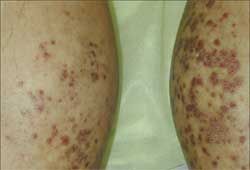
Figure 2 – Eczematid-like purpura of Doucas and Kapetanakis, seen here on an elderly man’s legs, can be distinguished from other benign pigmented purpuric dermatoses by the presence of scale.
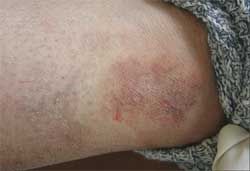
Figure 3 – The rash on this woman's arm is typical of Majocchi disease (purpura annularis telangiectodes).
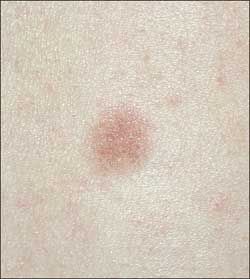
Figure 4 – Lichen aureus (golden purpura) is one of the benign pigmented purpuric dermatoses.

Figure 5 – Petechiae on this elderly man’s legs are characteristic of Schamberg disease, which usually affects the lower extremities.
These dermatoses manifest with petechiae and purpura; they usually occur on the legs, but any area of the body can be affected. Although they are cosmetically unattractive, they are not associated with serious sequelae. Sometimes pigmented purpura is pruritic.
Schamberg disease can occur at any age. Itching purpura and the dermatosis of Gougerot and Blum mainly affect middle-aged men. Lichen aureus and Majocchi disease are predominantly diseases of children and young adults.
The cause of pigmented purpura is unclear, and the lesions can resolve spontaneously. Treatments include topical corticosteroids and topical vitamin C.
An important consideration when you assess a patient with widespread pigmented purpura is that such a presentation can in fact be cutaneous T-cell lymphoma.1 Extensive pigmented purpura should be biopsied and the specimen sent to a dermatopathologist for evaluation.
CHERRY ANGIOMAS
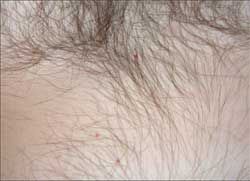
Figure 6 – Cherry angiomas are often widespread and typically occur on the torso, as in this patient.

Figure 7 – This red dome-topped papule is a cherry angioma.
Cherry angiomas, also known as cherry hemangiomas, represent dilated venules. They are the most common cutaneous vascular proliferations. Ranging in size from 0.1 mm to 1 cm, cherry angiomas appear as pinpoint macules (Figure 6) or as cherry red to purple dome-topped or polypoid papules (Figure 7). They are often widespread and tend to grow in size and number over time. Rarely, a lesion demonstrates a dark brown to an almost black color when a hemorrhagic plug occupies the vascular lumen.
Cherry angiomas typically present in men and women in their 30s and 40s. In patients who are predisposed to the development of these lesions, an increasing number appear with age.2 They are most common on the torso and are less common on the arms and legs; they occur even less frequently on the face and almost never on the mucous membranes.
If you have any doubt about the nature of a lesion resembling a cherry angioma, consider a shave biopsy. The optimal treatment of cherry angiomas is either curettage and electrodesiccation or pulsed dye laser therapy. I prefer the former because of its effectiveness and low cost. Curettage eliminates the angioma through tissue destruction. The risk of scarring usually is minimal when curettage is performed with skill. The use of a pulsed dye laser with a green light source allows selective absorption of the laser energy by the hemoglobin contained within the red blood cells in the venules and subsequent obliteration of the vascular lumen.
VENOUS LAKES
Venous lakes appear as dark blue to purple distensible 0.5- to 2-cm papules (Figure 8). The surrounding skin usually exhibits actinic damage. The lesions occur on sun-exposed areas, particularly the lips and ears of elderly men. The average age of presentation is 65 years. Venous lakes are usually asymptomatic, although pain, tenderness, and excessive bleeding can occur if they are traumatized.

Figure 8 – Venous lakes occur on sun-exposed areas, particularly the lips and ears. They represent dilated venules.
Venous lakes represent dilated venules, and they commonly contain thrombi. The likely cause of these lesions is chronic solar damage to the skin’s vasculature and ground substance that results in dilatation of superficial venous structures with associated thrombosis.
Venous lakes can usually be diagnosed clinically. Diascopy performed by placing a glass microscope slide against a venous lake and applying direct pressure will cause the lesion to blanch, sometimes incompletely, as its contents are emptied. Cherry angiomas, basal cell carcinoma, and nodular melanoma-which can mimic venous lakes-will not change color with diascopy.
A shave biopsy can be performed for definitive diagnosis and removal. Electrosurgery and pulsed dye laser therapy are the treatments that yield the best cosmetic results.
VARICOSE VEINS
Varicose veins and spider telangiectasia are normal veins that have dilated because of increased venous pressure. They are the visible surface manifestation of underlying vascular insufficiency.
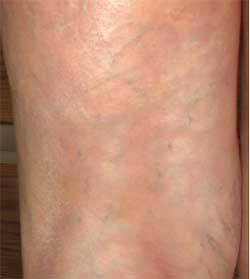
Figure 9 – Varicose veins are seen here on the leg of an elderly woman. Older adults are at increased risk for varicosities because the aging elastic lamina of the vein thins and its smooth muscle degenerates, resulting in irreversible venous dilatation.
Varicose veins range in size from 1 mm to 1 cm in diameter; they vary in color from green to red to blue (Figure 9). Small varicose veins are usually pinkish red, whereas larger vessels are blue or purple.
Varicose veins are more common in women than in men. In one study, varicosities were observed in 72% of women aged 60 to 69 years.3 Age is an independent risk factor for the development of varicose veins because the aging elastic lamina of the vein thins and its smooth muscle degenerates, resulting in irreversible venous dilatation.
Intrinsic pathological and extrinsic environmental elements dictate the development of varicose veins. Venous insufficiency involves incompetence of valves in the veins, which allows blood to move in a retrograde direction toward the leg rather than toward the heart. The symptoms of venous insufficiency include pain, soreness, burning, aching, throbbing, cramping, muscle fatigue, and “restless legs.”
Most varicose disease is caused by elevated superficial venous pressures; however, some persons have congenital vein wall fragility. Women are particularly susceptible to varicose veins because vein walls and valves periodically become more distensible under the influence of cyclic increases in progesterone.4 Pregnancy also increases the incidence of varicose veins.5
New varicose veins can be easily distinguished from chronic varices by palpation. Newly dilated vessels sit on the surface of the muscle or bone; chronic varices erode into underlying muscle or bone, creating deep “boggy” or “spongy” pockets in the calf muscle and deep palpable bony notches, especially over the anterior tibia.
Lipodermatosclerosis, atrophie blanche, bleeding varices, truncal varices, and ulceration are indications for treatment. Conservative management involves the use of venous compression hose; more active treatment options include surgical stripping of the affected veins. Smaller varicose veins can be treated with injection sclerotherapy.
SPIDER TELANGIECTASIA

Figure 10 – Spider telangiectasia on this woman’s leg is asymptomatic; treatment is not required except for cosmesis.
Spider telangiectases (spider veins) are flat red blood vessels that are 0.1 to 1 mm in diameter, although their actual diameter may be up to 3 mm under the skin surface (Figure 10). The precise origin of the disorder is unknown, but heredity, pregnancy, hormonal changes, weight gain, and leg injury may be contributing factors.6
Sometimes a cluster of spider telangiectases may appear as a red or purple patch (telangiectatic matting) that may be mistaken for a bruise. Unlike bruises, however, spider vein mattings do not fade. An ankle flare is a cluster of spider telangiectases, usually associated with varicose veins, that is located on the ankle (Figure 11); it can be related to chronic venous insufficiency.
Most spider telangiectases are not symptomatic and are generally considered a cosmetic problem. However, some spider veins, especially those that develop from deeper “reticular” or feeder veins, are accompanied by a burning sensation or a dull, throbbing pain.
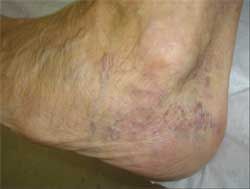
Figure 11 – This cluster of spider telangiectases below an elderly woman’s malleolus is an ankle flare. It is usually associated with varicose veins and can indicate underlying chronic venous insufficiency.
Treatment involves the use of irritating liquids, such as hypertonic saline or sodium tetradecyl sulfate, to perform sclerotherapy. Laser therapy can be an adjuvant to sclerotherapy, but it should not be used as monotherapy. Patients whose skin is very flabby are not optimal candidates for sclerotherapy because of the difficulties of injecting the irritating liquids and the possibility of leakage, which can lead to ulceration. Advise patients that treatment does not prevent the development of new spider telangiectases.
References:
REFERENCES:1. Robson A. The pathology of cutaneous T-cell lymphoma. Oncology (Williston Park). 2007;21(2, suppl 1):9-12.
2. Odom RB, James WD, Berger TB. Dermal and subcutaneous tumors: cherry angiomas. In: Andrew’s Diseases of the Skin: Clinical Dermatology. 9th ed. Philadelphia: WB Saunders; 2000:751.
3. Beaglehole R. Epidemiology of varicose veins. World J Surg. 1986;10:898-902.
4. McCausland AM, Holmes F, Trotter AD Jr. Venous distensibility during the menstrual cycle. Am J Obstet Gynecol. 1963;86:640-645.
5. Barwin BN, Roddie IC. Venous distensibility during pregnancy determined by graded venous congestion. Am J Obstet Gynecol. 1976;125:921-923.
6. Martin SP. Chronic venous disease: office evaluation. Consultant. 2006;46:1017-1024.
Therapeutic Agents in This Article
Hypertonic saline
Sodium tetradecyl sulfate (Sotradecol)
Topical vitamin C